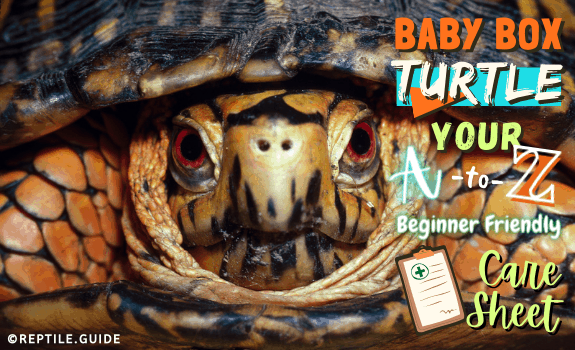Box turtles are one of the most popular reptile pets in the United States. Unfortunately, many people buy baby turtles and then have no idea what to do with them.
While baby box turtles have more care needs than some other species, taking care of them is far from difficult. Join us as we talk about it, and see if you have what it takes.
In This Article
In Short
- These turtles eat a mainly meat-based diet.
- Box turtles are active species and need plenty of space.
- As long as your turtle has sufficient lighting, heating, and environmental enrichment, it will be happy.
I Found a Baby Box Turtle, What Do I Do?
While baby box turtle care is an easy task, we DON’T recommend keeping a wild turtle baby if you find one.
If you find a baby box turtle outside, consider the environment. Most people seem to discover baby box turtles on roadways or in densely populated human areas.
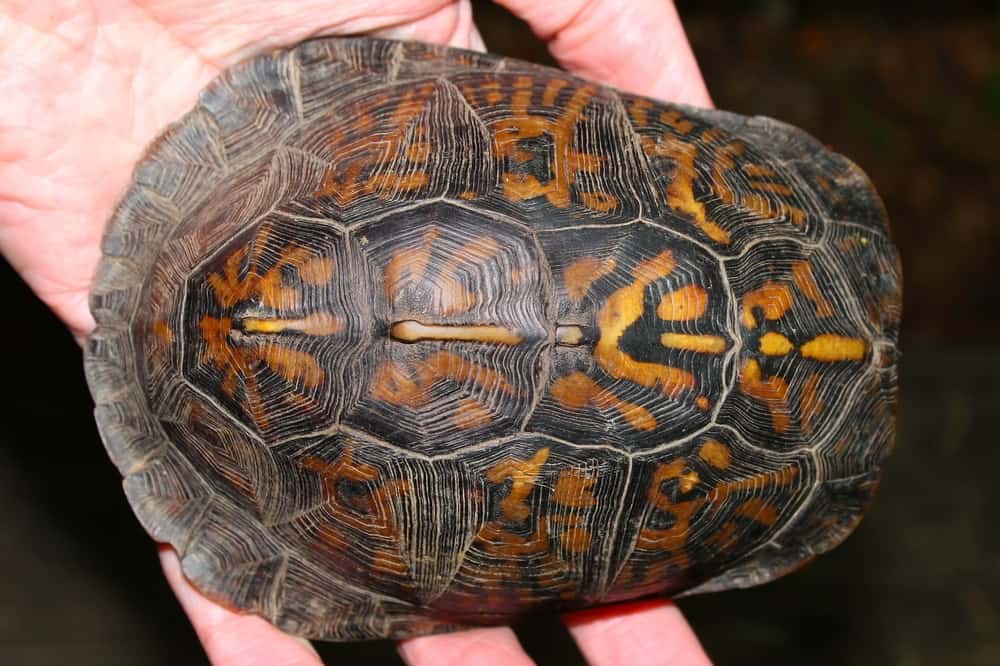
If you find a tiny turtle crossing the road, or a big one, pick it up carefully and move it to the other side of the road (in the direction it was heading).
While holding the animal, examine the turtle closely for any signs of injury. Many unfortunate turtles have had negative encounters with human transport.
If the turtle shows any signs of injury, or looks sick, place it in a simple plastic container, like a tote, and take it to the nearest animal sanctuary.
Things are different if the animal is unharmed, but you’re in an area where the turtle is likely to get hit by a car, or there’s not much natural habitat.
We recommend contacting a nearby animal sanctuary and asking them if you should relocate the turtle and where to.
Under NO circumstances should you take the turtle home.
Most pet stores stock box turtles, so if you want a pet box turtle, buy a baby.
How to Get a Baby Box Turtle to Eat
Giving your baby box turtle food is relatively easy, and they’re NOT overly picky.
One thing to note is that box turtles are mainly carnivorous (70%), and an entirely plant-based diet can make your turtle sick.
Adult box turtles eat a lot less frequently than babies, once every two days usually. Tiny hatchlings and young tortoises need to eat about twice a day.
Most keepers have a problem getting a baby turtle to eat because they give the animal plant matter, like leafy greens or dry turtle pellets.
Since box turtles have a mainly meat-based diet, that’s unlikely to do the trick.
In general, as long as you place a good food mix in front of your baby turtle’s eyes, they’ll just chow down.
What Do Baby Box Turtles Eat?
By now, you’re probably wondering, precisely what do baby box turtles eat?
While you can buy pre-made turtle food for your pet, it shouldn’t be the main element in your turtle’s diet.
While a baby turtle might survive on an artificially produced diet, it will thrive on a more natural diet.
If you want to use a formulated turtle food, we suggest giving it to your turtle no more than twice a week, or four times a week if you only use it one meal out of two.
There are many outstanding elements that you can use in your baby box turtle’s diet.
Always bear in mind that these are highly carnivorous omnivores, so provide more meat-based foods than vegetables.
Meat-based food items include:
- Garden worms (if you don’t use pesticides in your yard or have friends who don’t)
- Farm-raised live foods like:
- Crickets
- Mealworms
- Earthworms
- Super worms
- Feeder roaches
- Sardines
- Millipedes
- Pinky mice
- Canned tuna
- Feeder goldfish
- Slugs and snails
- Soaked dry dog food
Pro Tip: NEVER include wild cockroaches, crickets, or other live food in your turtle’s food mix. Wild insects may carry nematodes, Coccidia, and a range of other parasites.
Your turtle also needs a certain amount of vegetable material in its diet. Options include:
- Green beans
- Sweet potato
- Romaine lettuce
- Escarole, chicory, or endives
- Leafy greens like spinach, mustard, kale, and turnip tops
If you truly want your baby turtle to thrive, you should provide a certain amount of fruit in its diet as well.
While green beans are technically a fruit, it’s low in sugar and closer to leafy greens in nutrients.
You can give your baby turtle the following fruits:
- Pear
- Apple
- Mango
- Grapes
- Sour cherries
- Banana (skin-on)
- Chopped raspberry
- Finely sliced orange
An essential part of box turtle care is managing their diet. You should always aim to give your baby turtle 70% protein, 20% vegetable, and 10% fruit.
Supplementation
Baby turtles need a high-quality calcium supplement.
Although some greens like kale, and many meat-based foods, contain plenty of calcium, your baby turtle needs A LOT of calcium to maintain bone and shell growth.
The best solution is to sprinkle their meal with a calcium supplement three or four times a week.
As the turtle grows, you can do it less frequently, and adult turtles do okay with supplements once a week.
The best way to ensure that your baby turtle gets enough of the supplement into its system is to use the following method:
- Put the turtle food in a plastic container with a tight-fitting lid.
- Add the recommended amount of calcium supplement to the food.
- Replace the container’s lid and shake it vigorously.
- Give the now calcium-coated food to your turtle.
Baby Box Turtle Habitat
If you know about the baby box turtle habitat in the wild, it can be helpful when you do your turtle’s tank.
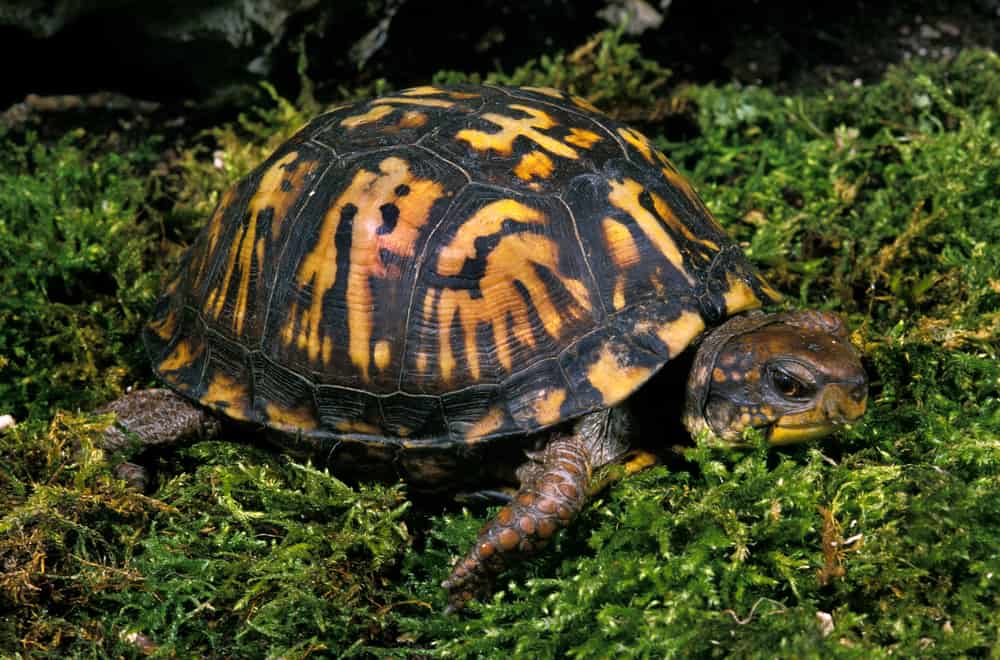
Baby box turtles naturally come from moist but not wet habitat types where they dwell among leaf litter.
The different types come from myriads of locations, and there may be acute divergence in their habitat types:
- Desert Box Turtles live in the Southern US.
- As the name suggests, Eastern Box Turtles live mainly in the Eastern United States.
- Florida Box turtles are a subspecies of the Eastern that dwells in, you guessed it, Florida.
- Gulf Coast Box Turtles are another subspecies of the Eastern, and live in a narrow strip of the Gulf Coast.
- Ornate Box Turtles live mainly in the Central United States, and their range overlaps with that of the Three-Toed.
- Three-Toed box turtles are another subspecies of the Eastern, which lives West of the Eastern and above the Gulf Coast, in the South-East Central Part of the US.
As you can see, box turtles come from a wide range of states and different habitats.
Depending on the species, and the state it hails from, the tiny hatchlings may emerge in one of many habitats.
Eastern box turtles prefer moist habitats like woodlands, meadows, grasslands, or areas near ponds and lakes.
Ornate box turtles thrive in a similar environment and tend to seek such habitats.
Desert box turtles are the apparent exception to the rule, and they live in arid and semi-arid habitats like deserts, plains, and dry steppe land.
More about how to use their habitat preferences to your (and their) advantage in the next section.
Housing Your Baby Box Turtle
While setting up your turtle’s tank is easy, there are some things you need to consider if you want your turtle to do as well as possible.
Enclosure Size
While your baby turtle may seem tiny when you get it, it’s going to get much bigger. On average, box turtles reach lengths of around seven inches.
These turtles are incredibly active and don’t deal well with an enclosure that’s too small. When you’re still dealing with a tiny hatchling, a simple plastic tote will do.
For a baby turtle, you’ll require an enclosure of at least four feet long by one foot wide. Ideally, it should have a height of around 9 inches.
As the turtle grows, it will require more and more space. Adult turtles need an enclosure at least three feet by three feet with at least one-foot height.
Many turtle owners opt to keep their adult turtles in an outdoor pen.
This technique is usually ideal because you can move the pen around as part of the turtle’s enrichment program.
Young turtles can also have an outside pen for the daytime, as long as they have a source of heat and protection from predators.
Tiny turtles can also be escape artists, so MAKE SURE that they can’t get out!
Housing baby turtles is truly easy, and you can choose between buying an aquarium, building a wooden enclosure, or adapting a plastic tote.
Some keepers go as far as having an indoor pen and an outdoor pen for their tortoises.
Pens are easy to make with a bit of imagination and easy to set up since the turtles use a heat lamp.
Pro Tip: These turtles are excellent climbers. If you decide to give them a pen, ensure that there’s nothing (including other tortoises) they can climb onto to get out of the enclosure.
Lighting
Many turtle owners find the concept of heating their pet’s enclosure bewildering. While it is necessary to provide your turtle baby with lighting, it’s not hard to do.
Your pet turtle requires light to provide them with a day and night cycle.
Without this differentiation of days and nights, the turtle’s biological clock will go awry, and it might get sick.
For the best results, we suggest giving your turtles a 12/12 light cycle. That means 12 hours on for daylight and 12 hours off to mimic nighttime.
You can quickly hook your turtle’s light up to a timer so that it automatically switches the light on and off at the right time.
We recommend giving your turtle full-spectrum lighting so that it can get enough UVA and UVB.
This type of turtle is sensitive to calcium shortages and cannot process calcium if it doesn’t get enough UVA and UVB.
To ensure that your turtle always gets the level of lighting and UV that it needs, replace the bulbs every four to six months.
While the globe may still work at that time, its UVA and UVB output diminishes over time and might not produce enough.
Heating
Baby turtles always require supplemental heating. Despite their broad distributions, these animals prefer warmer regions.
There are many potential heating sources that you can use in your turtle tank. Many people use heat mats or heat tape, but they’re not ideal for these animals.
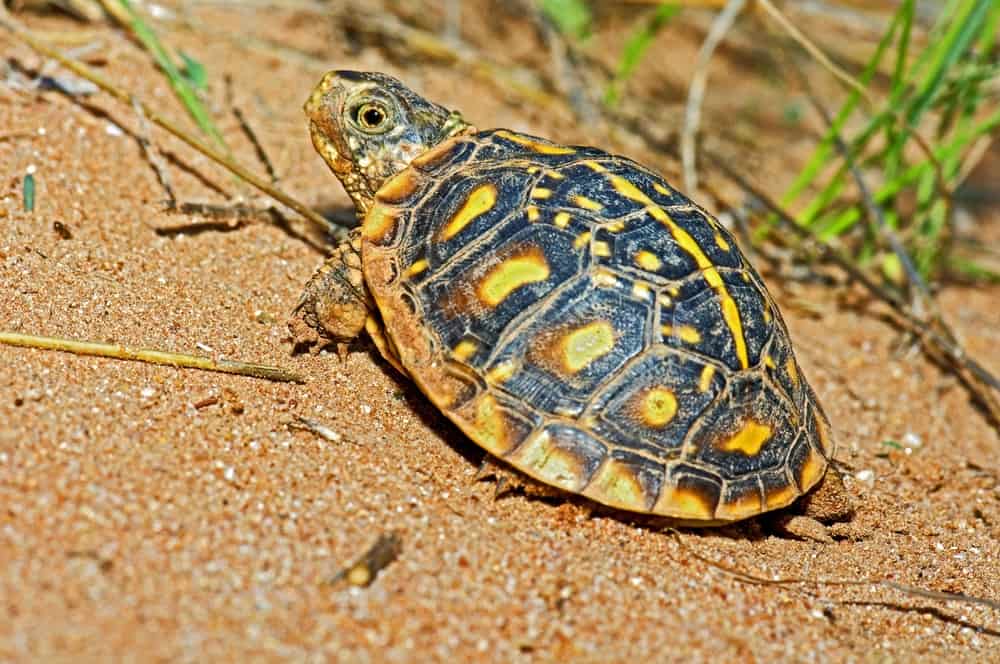
The best heat source for your turtle is a heat or basking lamp. It allows the animal to bask as it would in the wild.
Choose a lamp of between 50 and 100 watts, and suspend it far enough above the substrate to keep the basking area in an ideal range.
Whether you have a baby box turtle or an adult box turtle, the temperature beneath the basking lamp should always be in the 85-88°F range.
The ambient temperature in the enclosure should be between 72°F and 75°F for a baby box turtle.
If you live in a generally cold place, you can use something like a digital heat mat to help keep the general temperature in the enclosure in range.
Substrate
The substrate is something that many turtle owners take for granted. The substrate is the ground beneath your turtle’s feet and can make all the difference to its comfort level.
Using a suitable, high-quality substrate will help maintain the humidity levels in your turtle’s enclosure.
Since these turtles spend a lot of time burrowing in nature, they will also be more comfortable.
Some suitable substrates include:
- Coconut coir
- Sphagnum moss
- Shredded hardwood mulch
- High-quality organic compost
You can use any one of these substrates or a mixture of them.
Pro Tip: Adding hardwood leaf litter or rehydrated sphagnum moss to your turtle’s substrate will help maintain moisture levels.
There are some substrates that you should never use. These include:
- Clay soil
- Corncob litter
- Any type of sand
- Recycled paper pellets
- Pine, fir, or cedar products
- Mulch with sharp shards of wood in it
- Compost with fertilizers or pesticides in it
Enrichment
Many people don’t realize that their baby turtles need environmental enrichment.
Think about how you would feel if you stayed locked in an empty room with no form of entertainment, and you only received food and water every day.
It would play havoc on your mental health, wouldn’t it? At best, you’d be unhappy. At worst, a little bit insane.
Unfortunately, many keepers unintentionally do precisely that to their young turtles. They only meet the turtle’s needs, which allows it to survive.
Box turtles are intelligent and active animals in the wild that travel to different locations every season.
They usually have one location for autumn and winter and another for spring and summer. Their general movements aren’t determined by temperature, though.
Since they’re such wild rovers in the wild, you can expect your turtle to want more than looking at the same four walls all the time.
Let’s look at a few ways you can help your turtle enjoy its life.
Turtle Toys
Believe it or not, your turtle can benefit from having toys to play with. It gives them something to do, spruces up their lives, and makes them happy.
What kind of toys do turtles like to play with? While they certainly won’t enjoy catnip mice or chew toys (we stand to be corrected), they enjoy other basic turtle toys.
Some of the options include:
- Plastic balls, like ping pong balls or kiddie golf balls
- Treat balls, like the ones you use for weasels or ferrets
- Rolling colored marbles (too big for the turtle to eat) around the cage
Cage Layout
How you set up your turtle cage can make a HUGE difference. There are many ways you can incorporate design elements that will help your tortoise love its home.
One of the excellent ways to use design for enrichment is incorporating live plants into the enclosure. Excellent choices include:
- Clover
- Plantain
- Java ferns
- Red sorrel
- Dandelions
- Lemon balm
The turtles WILL eat these plants, so don’t have dreams about a beautifully landscaped terrarium for your pet.
Instead, our advice to you is to buy seeds and start many plants every few months.
Moving the decorations around once a week is another excellent way to break the monotony of your baby turtle’s life.
Don’t move the hide or food and water bowls, but you can include and move elements like:
- Plastic or silk plants that the turtle can’t eat
- Clean branches that don’t have sharp edges
- Smooth rocks and pebbles that the turtle can climb over
- Cork bark and other harmless items the baby turtle can hide under
Remember that hides and shelters are an essential part of your turtle’s enclosure.
Without them, it will feel vulnerable and unsafe. There are many excellent options on the market for you to choose from.
Options include:
- Cork Bark
- Clay Flowerpots
- Aquarium caves
- Other branded reptile hides
Handling a Baby Box Turtle
Whether it’s a baby box turtle or an older box turtle, handling is a simple thing. Always bear in mind that, though they don’t bite easily, box turtles aren’t fond of handling.
Before handling your box turtle baby:
- Wash your hands
- Check that it’s not sleeping or eating
- Ensure that it’s not in a grumpy mood
There are a few easy steps to follow when picking up your turtle:
- From behind, place a thumb on one side of the shell, and four fingers on the other side
- If you’re picking up an older box turtle, pick it up with a hand on each side of the shell
- Don’t squeeze, but hold the turtle firmly so that it doesn’t fall or slip out of your grasp
- NEVER pick up your turtle by any of its legs, or turn it quickly
If you handle your baby box turtles frequently, they’re more likely to get used to it.
Most box turtles aren’t fond of handling, but they’re unlikely to bite unless they’re highly stressed.
Baby Box Turtle Hibernation
While baby turtles would naturally hibernate in nature if they lived in an area with a cold winter, it’s not always wise to allow your pet turtle to hibernate.
During hibernation, a baby turtle slows down all its bodily functions to a near-halt.
If your pet is ill before entering hibernation, its body won’t have the strength to fight off the disease.
You should only allow your baby turtle to enter hibernation if you’re sure that it’s healthy.
Hibernation is most common in pet turtles that stay outdoors in cool areas, and your pet won’t suffer harm if it doesn’t hibernate.
You can skip hibernation by keeping your turtle warm and well-lighted during the cooler months.
Ensure that the turtle stays at consistently summer-like temperatures, though.
A failed attempt at hibernation can be fatal, so make sure that your baby turtle is kept warm.
For new keepers, we suggest this approach, as there’s less stress and potential problems involved.
Baby Box Turtle Pictures
We’ve gathered one or two baby box turtle pictures for you to enjoy.
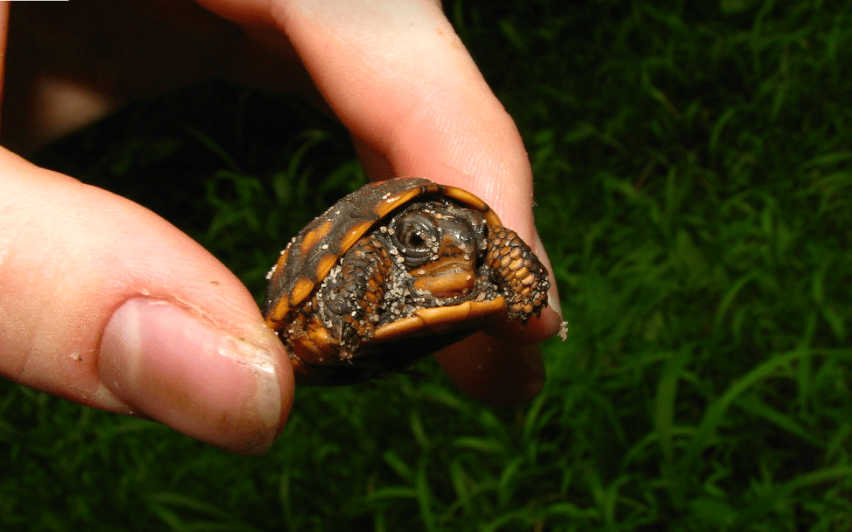
Property of and uploaded to Flickr.com by Kerry Wixted
Image title: Baby Box Turtle
Copyright: (CC by 2.0)
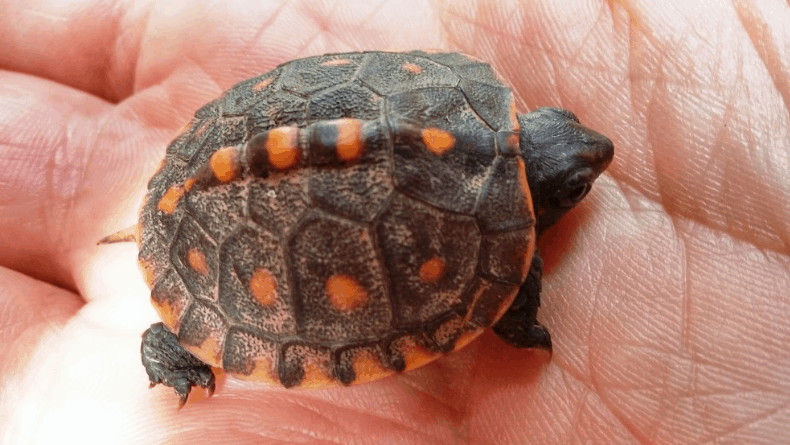
Uploaded to Flickr.com by USFWS Midwest Region
Eastern Box Turtle vs. Common Box Turtle
There are three types of box turtle commonly sold in US pet stores. They are the:
- Ornate Box Turtle (Terrapene ornata)
- Eastern Box Turtle (Terrapene carolina carolina)
- Three-Toed Box Turtle (Terrapene carolina triunguis)
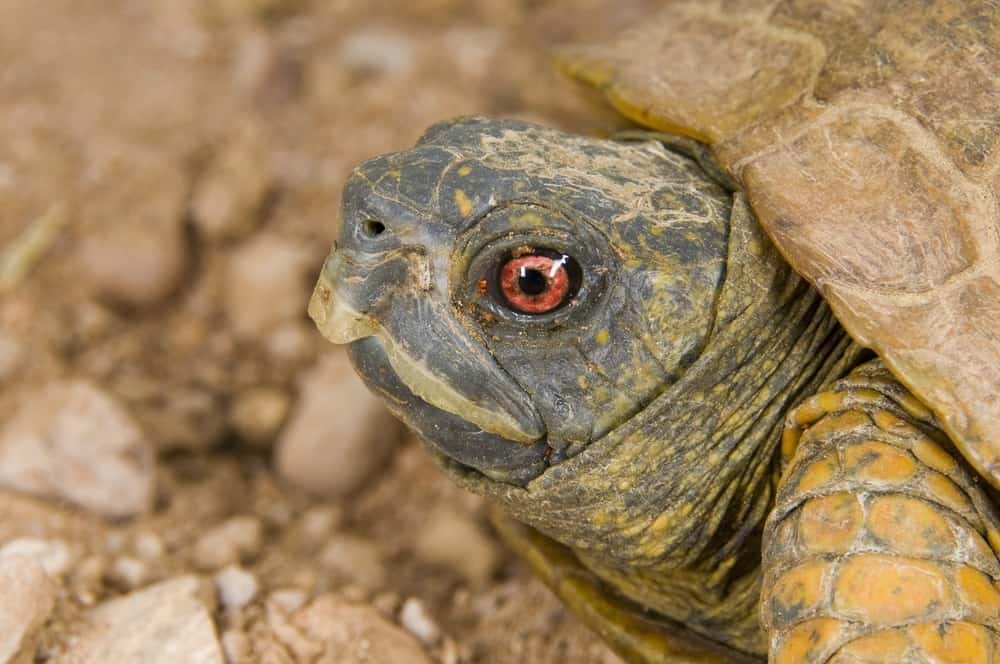
Some keepers find or buy a baby eastern box turtle or three-toed box turtle, then worry about the differences between Eastern and other box turtles.
Fortunately, the differences between the three types of turtle are primarily in appearance.
Baby box turtles of the different types look much the same, so we’ll talk about an adult eastern box turtle instead.
Eastern box turtles have:
- Four toes on each hind foot
- Bright orange and yellow markings on their high-domed shells
Three-toed box turtles have:
- Three toes on each hind foot
- A tan shell that lacks markings
Ornate box turtles have:
- Four toes on each hind foot
- A dark shell covered in light bands and spots
If you found your baby box turtle in the wild, you may also be contending with a
- Florida Box Turtle
- Desert Box Turtle
- Gulf Coast Box Turtle
These three species have much smaller distributions, so it’s improbable that you’ll see many in captivity. You can check out our detailed guide to turtle identification if you’re not sure.
Whichever type you have, this care sheet for baby turtles will help you care for them.
If you’ve not decided which kind of turtle you want yet, check out our list of the best pet turtles.
Perhaps you don’t want to dedicate that much space to a pet tortoise (more about turtles vs. tortoises here)? Check out our guide to the best small turtles to keep as pets.
Now that you know all about keeping baby box turtles, are you going to get one? Let us know in the comments below.
